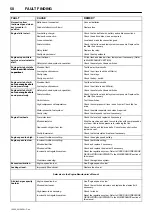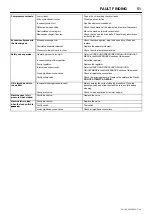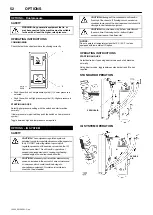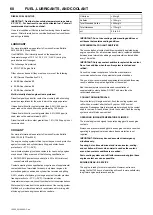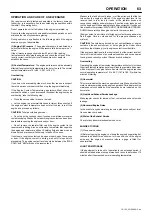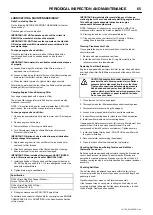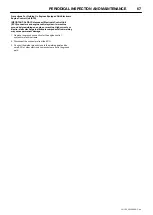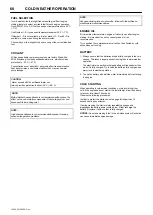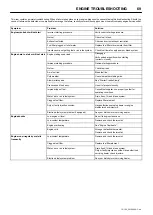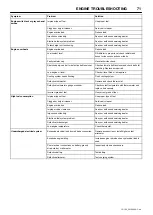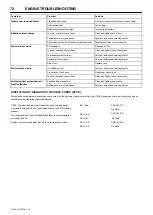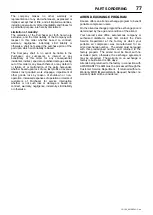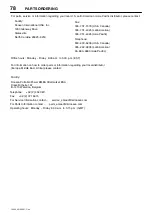
63
OPERATION
12/150_23136625
−
C en
OPERATION AND CARE OF A NEW ENGINE
.
Your engine is carefully tested and adjusted in the factory, however,
further run
−
in is necessary. Avoid any harsh engine operation within
the initial 100 operating hours.
Do not operate the unit at full load until the engine is warmed
−
up.
Do not allow the engine to run unloaded for extended periods so as to
minimise the risk of cylinder bore glazing.
During operation, pay attention to the following points if the engine
shows any sign of abnormalities.
(1) Engine Oil Pressure
−
The engine oil pressure is monitored by a
switch that will stop the engine if the pressure falls below a pre
−
set
value.
If the oil pressure gauge shows below 30 psi or if the reading
fluctuates continually, stop the engine and check the oil level. If the
level is correct, contact your local Doosan branch or dealer to
establish the cause.
(2) Coolant Temperature
−
The engine performance will be adversely
affected if engine coolant temperature is too hot or too cold. The normal
coolant temperature is 75 to 85
C (167 to 185
F).
Overheating
CAUTION:
If you see or hear escaping steam or have other reason to suspect
there is a serious overheat condition, stop the engine immediately.
If the Engine Coolant Temperature gage (where fitted) shows an
overheat condition, or you have reason to suspect the engine may be
overheating, take the following step:
Close the service valve to reduce the load.
Let the engine run at normal idle speed for two or three minutes. If
the engine coolant temperature does not start to drop, turn off the
engine and proceed as follows:
CAUTION:
To help avoid being burned
−
Do not open the canopy or door if you see or hear steam or engine
coolant escaping. Wait until no steam or engine coolant can be seen or
heard before opening the engine canopy or door.
Do not remove the radiator filler cap if the engine coolant in the
reserve tank is boiling. Also do not remove the radiator filler cap while
the engine and radiator are still hot. Scalding fluid and steam can be
blown out under pressure if either cap is taken off too soon.
If no steam or engine coolant can be seen or heard, open the canopy
or door. If the engine coolant is boiling, wait until it stops before
proceeding. The engine coolant level should be between the “MAX
COLD” and “MIN” marks on the reserve tank.
Make sure the fan belt is not broken, or off the pulley, and that the fan
turns when the engine is started. If the engine coolant level in the
reserve tank is low, look for leaks at the radiator hoses and
connections, radiator, and water pump. If you find major leaks, do not
run the engine until these problems have been corrected. If you do not
find a leak or other problem, WAIT UNTIL THE ENGINE HAS COOLED
DOWN then carefully add engine coolant to the reserve tank.
(Engine coolant is a mixture of ethylene glycol antifreeze and water.
See “Engine Care in cold season” for the proper antifreeze and
mixture.)
CAUTION:
To avoid being burned, do not spill antifreeze or engine
coolant on the exhaust system or hot engine parts. Under some
conditions the ethylene glycol in engine coolant is combustible.
If the engine coolant level in the reserve tank is at the correct level but
there is still an indication of an overheat condition and no cause was
found, please consult your local Doosan branch or dealer.
Overcooling
Operating the engine at low coolant temperature will not only increase
the oil and fuel consumption but also will lead to premature parts wear
which may result in engine failure. Ensure that the engine reaches
normal operating temperature 75 to 85
C (167 to 185
F) within ten
minutes of starting.
(3) Hourmeter
This meter indicates the machine operation hours. Make sure that the
meter is always working during engine operation. Periodical machine
maintenance is scheduled on the operation hours indicated on the
hourmeter.
(4) Liquid and Exhaust Smoke Leakage
Make regular checks for lubricant, fuel, coolant and exhaust smoke
leakage.
(5) Abnormal Engine Noise
In the event of any abnormal engine noise, please consult your local
Doosan branch or dealer.
(6) State of the Exhaust Smoke
Check for any abnormal exhaust smoke color.
ENGINE STOPPING
(1) Close service valves.
(2) Before stopping the engine, cool down the engine by operating it at
reduced load about three minutes. In this period, check the engine
noise and the engine oil pressure (where a gage is fitted) for
abnormalities.
LONG TERM STORAGE
If the equipment is to be out of operation for an extended period, it
should be started at least once per week and run on load for about 15
minutes after it has reached normal operating temperature.


